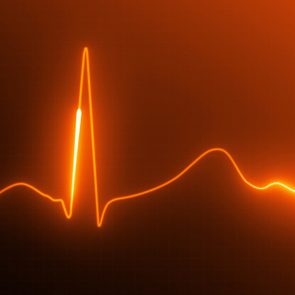What Is a Ventricular Arrhythmia? Symptoms, Diagnosis, and Treatments
Updated: Feb. 10, 2021
A ventricular arrhythmia is a rapid heartbeat that originates in the heart's lower chamber and can be life-threatening. Here's what to know.
Ventricular arrhythmias: An electrical issue
Heart arrhythmias come in a lot of different forms—including ventricular arrhythmias. In general, heartbeat problems stem from issues with your heart’s electrical system.
An area of cells in your heart called the sinus node—it’s your heart’s pacemaker—sends a signal to the heart muscle that triggers a contraction. The node starts the heartbeat in the upper chambers (atria). Next, the signal travels to the atrioventricular node and other branches and fibers to the lower chambers (ventricles), and all the chambers contract in order.
An irregular heartbeat, also called a heart arrhythmia, occurs when there is a malfunction in this otherwise finely tuned electrical system. An arrhythmia doesn’t give the heart a chance to refill before pumping, which means the rest of the body isn’t getting the sufficient supply of blood it needs to function. For some, ventricular arrhythmia—a rapid heartbeat that starts in the heart’s lower chambers—can come and go with or without noticeable symptoms, yet in others, it could become a life-threatening condition in just minutes.
Here’s what you should know about the risks and consequences of ventricular arrhythmias. (Learn these signs of an unhealthy heart.)
Types of ventricular arrhythmias
Ventricular arrhythmias originate in the heart’s lower chambers and include two distinct conditions: tachycardia and fibrillation. Both produce a rapid heartbeat and can be life-threatening. The defining difference between the two arrhythmias is in the nature of their beats. In ventricular tachycardia, the beat is rapid but regular, whereas ventricular fibrillation is rapid and irregular.
Ventricular tachycardia
When ventricular tachycardia (VT) occurs, it doesn’t give the heart enough time to refill with blood before pumping, which means the rest of the body isn’t getting a steady supply of blood as it should. This may lead to dizziness, lightheadedness, loss of consciousness, and cardiac arrest. Persistent VTs could point to an underlying heart problem, such as coronary artery disease, heart failure, or a previous heart attack.
Ventricular fibrillation
The fast and chaotic signals that occur in ventricular fibrillation (VFib) make it the most dangerous of the two. The disorganized signals cause uncontrolled quivering of the ventricles, which render them useless in getting blood to the body and the brain. VFib is a medical emergency as the brain and body are no longer receiving blood from the heart.
Treatment must be immediate. VFib could result in sudden cardiac arrest or death. According to the Heart Rhythm Society, sudden cardiac arrest brought on by VFib is responsible for half of all heart-related deaths. CPR can improve survival rates until defibrillation is done to restore normal rhythm.
Torsades de pointes
People with long QT syndrome—a heart condition that can lead to fast heartbeats and cause fainting or sometimes sudden death—are likely to develop this type of ventricular arrhythmia. Triggered by an electrical problem, the heart takes longer to recharge after each heartbeat and reduces blood flow. Short episodes of torsades de pointes tend to last less than a minute and include fainting and loss of consciousness. However, if it lasts longer, it can lead to VFib.
(This is how to do CPR.)

Ventricular arrhythmias symptoms
In some cases, ventricular arrhythmias can occur without any warning signs at all. Some people may experience the following symptoms:
- Palpitations (fluttering and fast heartbeat)
- Light-headedness
- Dizziness
- Chest pain
- Loss of consciousness
Symptoms of heart failure may also be evident. They include:
- Swelling in the legs or stomach
- Shortness of breath
- Difficulty exercising
- Fatigue
- Decreased mental sharpness
(This is why heart failure can cause swollen feet.)
Ventricular arrhythmias causes and triggers
As with other types of arrhythmias, ventricular arrhythmias may be triggered or caused by several different things or conditions—too lengthy to list here. Here are some common causes and triggers:
- Caffeine
- Electrolytes imbalance
- Physical or emotional stress
- Dehydration
- Infection or fever
- Infections or inflammation of the heart muscle
- Over-the-counter medicines for allergy, sinus, cough, and cold
- Herbal and diet supplements
- Alcohol and drugs
- Thyroid disease
- Genetic diseases that affect the heart’s electrical system
- Underlying heart issues such as coronary artery disease and cardiomyopathy
When are ventricular arrhythmias dangerous?
Most of the time, ventricular arrhythmias that occur in healthy people with no structural heart disease are harmless. These individuals may have little or no noticeable symptoms. Yet, for some people, ventricular arrhythmias can be deadly.
They can come on suddenly, without warning. So how do we know when a ventricular arrhythmia is dangerous? “Ventricular arrhythmias are most dangerous when they don’t stop on their own, what we refer to as ‘sustained,'” says Ryan Cunnane, MD, an electrophysiologist cardiologist at the Michigan Medicine Frankel Cardiovascular Center and assistant professor of internal medicine.
Sometimes, however, they can occur as short bursts that stop spontaneously. These “nonsustained” episodes can often happen before a more dangerous sustained event, says Dr. Cunnane. Sustained or nonsustained ventricular arrhythmia isn’t something you should try to figure out on your own. Because the presentation and treatments can vary, make an appointment to see your doctor as soon as possible for evaluation.
Diagnosing ventricular arrhythmias
Your doctor will ask about your medical history and your family history to understand your specific symptoms and their severity. Some heart arrhythmias and heart conditions are genetic. You’ll also discuss details about when you experience an irregular heartbeat.
Your doctor will want to know how often they happen, how long they last, the factors leading up to them, and how they were stopped. Next, some diagnostic tests are in order. They will likely include one or more of the following:
Electrocardiogram (ECG OR EKG)
A non-invasive test that shows how fast your heart is beating and if the rhythm is regular or irregular. If you have ventricular tachycardia during the ECG, the abnormal beats may point to the location of the arrhythmia.
Ambulatory ECG monitor
A small device you wear that records the electric activity in your heart while you go about your daily activities. These types of monitors are especially helpful if you didn’t have an irregular heart rhythm while the ECG was being done. These monitors may be worn for 24 hours or up to two weeks.
Echocardiogram
An ultrasound that can pick up the presence of heart disease. The video records the heartbeat, size, and shape of the heart chambers, and even any previous heart attack damage.
Stress test
A test on the treadmill or bike is done for those who report experiencing irregular heartbeats or chest pain while exercising. It helps to assess artery blockage and provoke an arrhythmia if the cause of the symptoms isn’t known.
Cardiac catheterization
A minimally invasive procedure to take a closer look at how the heart is functioning by looking for artery blockage, muscle function, and the pressure inside the heart.
Cardiac MRI
A test that shows more in-depth information than an echocardiogram. It can show detailed images of the heart’s structure, function and can reveal scarring.
Electrophysiology study and mapping
A minimally invasive test of the heart’s electrical system to help determine the course of treatment. Tiny pulses are delivered to speed up the heart’s rhythm and to assess the ability to trigger an arrhythmia. The electrical signals your heart produces are recorded allowing doctors to map out where the abnormal rhythm is stemming from. Electrical signals are also measured to identify if they are normal or abnormal. Abnormal signals usually mean scarring or an underlying heart problem exists.
Treating ventricular arrhythmias
Since ventricular arrhythmias have the potential to be life-threatening, it’s a good idea to let your doctor know if you had one—even if the fast heartbeat or fluttering disappeared quickly. “Because the presentation and treatments can vary, prompt evaluation is important,” says Tina Ghia, MD, who specializes in cardiac electrophysiology at Kaiser Permanente in Bellevue, Washington. “Anyone who has been diagnosed with a ventricular arrhythmia should be under the care of a cardiac specialist (cardiologist or electrophysiologist) and attend in-person evaluations, as recommended by their doctor,” adds Dr. Ghia.

Medications to treat ventricular arrhythmias
“For patients with a known history of ventricular tachycardia or ventricular fibrillation, cardiac electrophysiologists (cardiologists who test and treat irregular heart rhythms) will often prescribe a class of medications called antiarrhythmics. These medications are used to try and prevent ventricular arrhythmias from occurring and are often used in conjunction with an implantable cardiac defibrillator (ICD) as a backup, says Dr. Cunnane.
Procedures for ventricular arrhythmias
Catheter ablation
Catheter ablation is a procedure done to find the ventricular arrhythmia and eliminate the problem causing it. Paul Wang, MD, cardiac electrophysiologist and director of the Stanford Cardiac Arrhythmia Service, in Stanford, California, says that a tiny tube (catheter) is inserted into the body and guided to the heart during the procedure. Then electrical impulses are delivered to trigger ventricular tachycardia.
Next, a GPS-like system pinpoints the location of the site responsible for the ventricular tachycardia. Energy is delivered using the catheters to kill the cells responsible for the ventricular tachycardia. The success rate depends on a few variables.
“For some patients, the location responsible for the ventricular tachycardia is in a relatively small region and is very close to the inner surface of the heart. In these cases, the success of the ablation is very high,” says Dr. Wang. “In other cases, however, the site may be deeper and more difficult to treat with energy and the success is lower. In addition, it may be difficult to locate the site that is responsible for the ventricular tachycardia and the success is lower.”
Implantable cardioverter defibrillator
“Patients with a life-threatening arrhythmia such as ventricular fibrillation may be a candidate for defibrillator therapy,” says Dr. Ghia. An implantable cardioverter-defibrillator (ICD) is a small, battery-powered device implanted under the skin. It continually monitors the heart rate.
If a fast, abnormal heart rhythm is detected, it will either stop the life-threatening rhythm with rapid pacing or deliver an electric shock to restore a normal beat.
“The decision to implant a defibrillator involves shared decision-making between the patient and their electrophysiologist,” says Dr. Ghia. “Unfortunately, ventricular arrhythmias can also occur without any warning signs at all. This is the main reason we recommend ICDs for those we know are at risk for developing them,” adds Dr. Cunnane.
(Here are the 25 heart-health secrets cardiologists want you to know.)
Lower your risk of ventricular arrhythmia
Unfortunately, a ventricular arrhythmia isn’t preventable for some people. The cause of ventricular arrhythmias is diverse. Some ventricular arrhythmias can be benign and managed with lifestyle modification and medications, and others are life-threatening.
But there are many things you can do to keep your heart healthy and thereby lower your risk of developing a heart condition that could make you more susceptible to ventricular arrhythmia.
- Embrace a heart-healthy diet
- Find fun ways to be physically active
- Maintain a healthy weight or lose weight if you need to
- Avoid the triggers mentioned above
- Manage other conditions that can lead to heart disease, such as high blood pressure, obstructive sleep apnea, and diabetes
- Control cholesterol levels
- Avoid drinking too much alcohol
- Quit smoking
- Learn how to manage stress
(These are the best heart-healthy products for your home.)
Living with ventricular arrhythmia
“The main consideration is that anyone diagnosed with a ventricular arrhythmia should be under the care of a cardiologist or electrophysiologist,” says Dr. Ghia. Catheter ablations are largely successful, and wearing an ICD is a good “insurance policy.” But living with an ICD presents its own challenges.
The first time you get a shock or feel the rapid pacing from wearing a defibrillator can be alarming and cause anxiety. Plus, there’s a list of specific instructions and guidelines for wearing and living with an ICD. Your mental and emotional well-being is vital to your physical well-being.
Don’t hesitate to talk to your healthcare team about what to expect and the steps you can take to improve the quality of your life.
Next, these are the things that happen when your heart stops.


